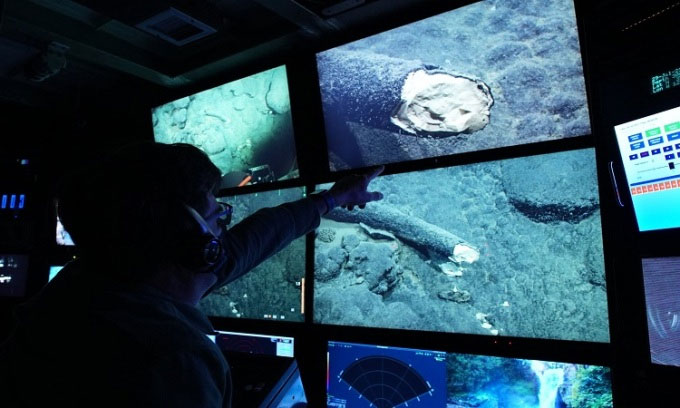Discovered mammoth tusks buried for nearly 3 million years on the seabed
Researchers discovered a tusk from a mammoth carcass that drifted and fell more than 3,000 meters below the Pacific Ocean.
A young female mammoth once roamed near what is now the Central Coast, California, USA and died there. Although the elephant died on land, its massive body ended up under the Pacific Ocean. Washed away by ocean currents, its body drifted more than 241km from the coast to a depth of 3,048m, next to a mountain under the sea. The elephant carcass had been lying there for millennia without anyone knowing it.

Scientist Steven Haddock points to a tusk on the Western Flyer's display. (Photo: Darrin Schultz/MBARI)
However, that all changed in 2019 when scientists from the Monterey Bay Aquarium Research Institute stumbled upon ivory while using a remote control vehicle to study new species of marine animals. Deep off the coast of Monterey (MBARI), California. The team seeks to collect the mysterious specimen. Unfortunately, the tip of the machete-shaped specimen was broken. They took a small piece and left the rest in place. It wasn't until examining the shard that researchers knew for sure they had encountered a tusk, but it was not clear what animal it came from and from what period.
The discovery of such a specimen in the deep sea is very unusual. The tusks and bones of prehistoric creatures are often buried deep underground or encased in permafrost near the Arctic Circle. Although some specimens are located in the shallow waters of the North Sea of Western Europe, researchers have never found traces of mammoths or any other ancient mammals in such deep water.
Steven HD Haddock, a marine biologist at the institute, often focuses on bioluminescence and ecology of deep-sea jellyfish. But he was intrigued by this particular scientific specimen. So Haddock assembled a team of scientists from the institute, the University of California, Santa Cruz, and the University of Michigan to uncover the mystery. Their preliminary research suggests that this is not just a mammoth carcass, but also an elephant that died at the end of the Paleolithic period, a period that spanned from 2.7 million to 200,000 years ago.
Further study of the specimen could help answer a long-standing question about the evolution of the North American mammoth. The discovery also suggests that the seafloor may be filled with paleontological specimens, helping to enhance our understanding of the past. But before the team could get to know the specimen, they had to return to the sea to collect the rest of the ivory.
On July 27, Haddock boarded the Western Flyer, MBARI's largest research vessel, along with many colleagues. Accompanying him were Daniel Fisher, a paleontologist at the University of Michigan, and Katherine Louise Moon, a postdoctoral researcher at the University of California, Santa Cruz, an expert on ancient animal DNA.
Before the trip, Moon collected enough DNA from the broken tip to determine that the tusk came from a female mammoth. Her conclusion was endorsed by Fisher. According to him, the shape and size of the tusks are characteristic of female mammoths. Terrence Blackburn, another researcher at the University of California, Santa Cruz, was not able to join the trip, but his preliminary analysis provides an estimate of the mammoth's age at death.
On board, it took the team just two days to reach the mountain under the sea, where the tusk is located. On the morning of July 29, the ship reached its destination. Haddock and his team immediately began searching. They gathered in the ship's control room. Through the screen, the team nervously watched the remote control vehicle named Doc Ricketts gradually lower into the water. When the vehicle reached its destination, the control room was filled with scientists, engineers and crew members, all eagerly watching the tusk recovery process.
Nearly everything on the undersea ridge below the vehicle is covered with a black iron-manganese coating. That makes finding the tusk difficult. However, after less than 15 minutes of searching, the tusk suddenly appeared in one of the screens. Haddock and his colleagues were concerned that the ivory might break when lifted, so they took the time to take pictures and video to build the 3D model in case the specimen broke during the recovery process.
Soft plastic fingers are attached to the arm of the vehicle for easier lifting of the tusk. The unmanned vehicle then places the specimen in the container. The process of finding and recovering the tusk took less than two hours. Not long after, the remote control vehicle was back on the water. Haddock and Fisher quickly removed the tusk to measure, clean, and photograph. They hope the specimen contains more mammoth DNA than the broken tip, enough to determine which species the mammoth in the water grave belongs to.
- Discover 400,000 years of mammoth tusks in Siberia
- Mexico discovered ivory 10,000 years before BC
- Discover rare and precious southern mammoth bones
- Discover the mummy of a young mammoth
- 12,000 years ago, two fighting mammoths came to wrap their tusks together, then died of starvation
- Revealing how extinct 'dodge' mammoths lived for 10,000 years
- 42,000 year old mammoth exhibition
- 15,000-year-old mammoth trap discovered in Mexico
- Fossil three million year old mammoth teeth on the English coast
- The 700,000-year fossil suspected to be 'precious' mammoth
- The thousand-dollar mammoth remains buried in ancient ice
- Display of mammoth corpses intact
 Discovered an ancient centipede fossil 99 million years old
Discovered an ancient centipede fossil 99 million years old Discovered bat-like dinosaurs in China
Discovered bat-like dinosaurs in China Discovered a 200-year-old bronze cannon of the coast
Discovered a 200-year-old bronze cannon of the coast Discover 305 million-year-old spider fossils
Discover 305 million-year-old spider fossils